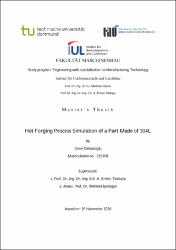| dc.contributor.author | Osmanoglu, Emre | |
| dc.date.accessioned | 2024-03-15T18:56:21Z | |
| dc.date.available | 2024-03-15T18:56:21Z | |
| dc.date.issued | 2021 | en_US |
| dc.date.submitted | 2020-11-26 | |
| dc.identifier.citation | Osmanoglu, Emre (2021). Hot forging process simulation of a part made of 304L. Türk-Alman Üniversitesi, Sosyal Bilimler Enstitüsü, İstanbul. | en_US |
| dc.identifier.uri | https://hdl.handle.net/20.500.12846/853 | |
| dc.description.abstract | The shift away from diesel cars in automotive industry results in new challenges in the
industry. As a result of this shift, manufacturers of gasoline engine parts must use dif ferent materials for same geometries for diesel engines because of the corrosive effect
of the diesel fuel. For the manufacturing process design, it is important to simulate the
process accurately to evaluate the feasibility of the operation. In this work hot forging
process of part made of 304L stainless steel is simulated with two different software
using finite element method to assess the feasibility of the forging process and provide
a basis for further simulations related to grain development. Once the parts are forged,
mechanical testing is done, and microscopy images of the workpiece are taken to eval uate the tensile strength, hardness, and delta ferrite content of the forged part. These
mechanical and microstructural properties of the part are studied to ensure the part con forms with the requirements of the working condition. Comparison of the simulation
results showed that the optimum way to simulate the process with respect to accuracy
and computation time is to employ finite element method with implicit solver and La grangian matrix. Testing results show forging temperatures of 1200 °C without quench ing or 1150 °C with quenching are the optimum points to obtain greater yield strength
and conforming delta ferrite content. | en_US |
| dc.language.iso | eng | en_US |
| dc.publisher | Türk-Alman Üniversitesi Fen Bilimler Enstitüsü | en_US |
| dc.rights | info:eu-repo/semantics/openAccess | en_US |
| dc.title | Hot forging process simulation of a part made of 304L | en_US |
| dc.type | masterThesis | en_US |
| dc.relation.publicationcategory | Tez | en_US |
| dc.contributor.department | TAÜ, Fen Bilimleri Enstitüsü, İmalat Teknolojisi Ana Bilim Dalı Koleksiyonu | en_US |

















